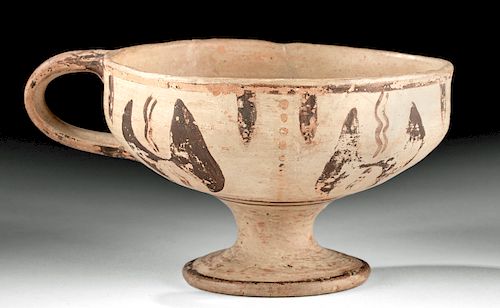Rare Minoan Cup w/ Labrys, TL Tested, ex-Christie's
Lot 23a
About Seller
Artemis Gallery
686 S Taylor Ave, Ste 106
Louisville, CO 80027
United States
Selling antiquities, ancient and ethnographic art online since 1993, Artemis Gallery specializes in Classical Antiquities (Egyptian, Greek, Roman, Near Eastern), Asian, Pre-Columbian, African / Tribal / Oceanographic art. Our extensive inventory includes pottery, stone, metal, wood, glass and textil...Read more
Estimate:
$9,000 - $12,000
Absentee vs Live bid
Two ways to bid:
- Leave a max absentee bid and the platform will bid on your behalf up to your maximum bid during the live auction.
- Bid live during the auction and your bids will be submitted real-time to the auctioneer.
Bid Increments
| Price | Bid Increment |
|---|---|
| $0 | $25 |
| $300 | $50 |
| $1,000 | $100 |
| $2,000 | $250 |
| $5,000 | $500 |
| $10,000 | $1,000 |
| $20,000 | $2,500 |
| $50,000 | $5,000 |
| $100,000 | $10,000 |
| $200,000 | $20,000 |
About Auction
By Artemis Gallery
Sep 26, 2019
Set Reminder
2019-09-26 10:00:00
2019-09-26 10:00:00
America/New_York
Bidsquare
Bidsquare : Exceptional Day 1: Antiquities & Asian Art
https://www.bidsquare.com/auctions/artemis-gallery/exceptional-day-1-antiquities-asian-art-4437
Day 1 of an important 2-day auction featuring exceptional, museum-worthy examples of Egyptian, Greek, Etruscan, Roman, Viking, Russian, Near Eastern, as well as Asian Art from China, Japan, Thailand, Vietnam, Burma and India. Artemis Gallery info@artemisgallery.com
Day 1 of an important 2-day auction featuring exceptional, museum-worthy examples of Egyptian, Greek, Etruscan, Roman, Viking, Russian, Near Eastern, as well as Asian Art from China, Japan, Thailand, Vietnam, Burma and India. Artemis Gallery info@artemisgallery.com
- Lot Description
Ancient Mediterranean, Island of Crete, Minoan Civilization, ca. late 15th century BCE. An exceedingly rare wheel-thrown pottery cup with a discoid foot beneath a slender stem, a wide body with squat walls, a slightly flared lip surrounding the shallow basin, and a single applied loop handle arching off of one side. The cream-slipped vessel is decorated with purple-brown slip that forms concentric rings around the lower body and top of the foot, wide stripes on the handle and around the rim, petite leaves draped along the rim exterior, and vertical bands of stippling. Evenly spaced around the exterior walls are four labryses - ceremonial double-headed axes with two fan-shaped blades - shown here with wavy central poles. A beautiful utilitarian example from the Minoan artisans! Size: 5.2" L x 4.2" W x 2.8" H (13.2 cm x 10.7 cm x 7.1 cm).
The Minoan double-axe, known as a labrys, was an important symbol of Minoan culture and religion. Labryses are considered by scholars to be one of the oldest symbols of Greek and pre-Greek civilization as its likeness was a recognizable character in the untranslated ancient language of Linear A. While practical uses of the labrys ranged from forestry, hewing, and other utilitarian tasks, they were also used in religious ceremonies that involved the ritual slaughtering of bulls; concurrently, the word "labrys" is etymologically connected to the word "labyrinth," the enormous maze-like creation that contained the mythological bull-headed beast known as the Minotaur. Their symbolism with women was also rather potent as they were associated with priestesses and certain female divinities. Women who owned a labrys were perceived as being of powerful statures and likely holding a position of importance within Minoan society.
For a stylistically similar example, please see: Demakopoulou, Katie. "The Mycenaean World: Five Centuries of Early Greek Culture, 1600-1100 B.C." National Hellenic Committee, Athens, 1988, p. 105, no. 36.
For four examples of the Minoan labrys, please see The Metropolitan Museum of Art, accession number 26.31.514: https://www.metmuseum.org/art/collection/search/252433
This piece has been tested using thermoluminescence (TL) analysis and has been found to be ancient and of the period stated. A full report will accompany purchase.
This piece is also accompanied by an Art Loss Register certificate, reference number S00050314.
Provenance: private Alabama, USA collection; ex-Roy Green collection; ex-Royal-Athena Gallery, New York, New York, USA, inventory number CLT124; ex-Christie's, London, South Kensington "Antiquities" auction (sale 8543, October 20, 1999, lot 163); ex-private English collection; accompanied by Art Loss Register certificate, reference number S00050314
All items legal to buy/sell under U.S. Statute covering cultural patrimony Code 2600, CHAPTER 14, and are guaranteed to be as described or your money back.
A Certificate of Authenticity will accompany all winning bids.
We ship worldwide and handle all shipping in-house for your convenience.
#148710Repaired from a few large pieces, with small chips and light adhesive residue along break lines. Minor area of restoration on rim. Minor nicks and abrasions to rim, handle, walls, basin, and foot, with fading and chipping to original slip pigment, and light encrustations within some recessed areas. Great traces of original pigmentation throughout. Two TL drill holes: one beneath foot, and one inside upper handle arch.Condition
- Shipping Info
-
All shipping is handled in-house for your convenience. Your invoice from Artemis Gallery will include shipping calculation instructions. If in doubt, please inquire BEFORE bidding for estimated shipping costs for individual items.
-
- Buyer's Premium



 EUR
EUR CAD
CAD AUD
AUD GBP
GBP MXN
MXN HKD
HKD CNY
CNY MYR
MYR SEK
SEK SGD
SGD CHF
CHF THB
THB
















